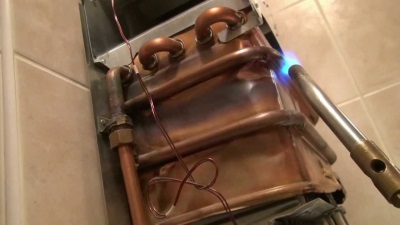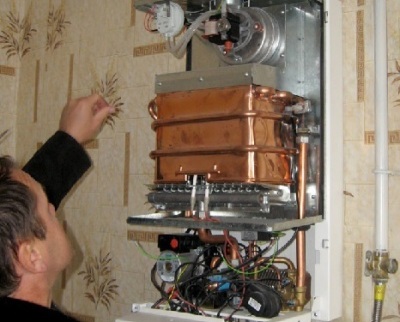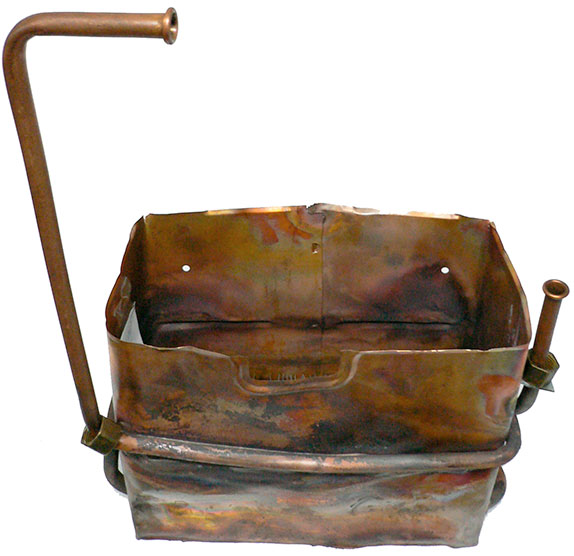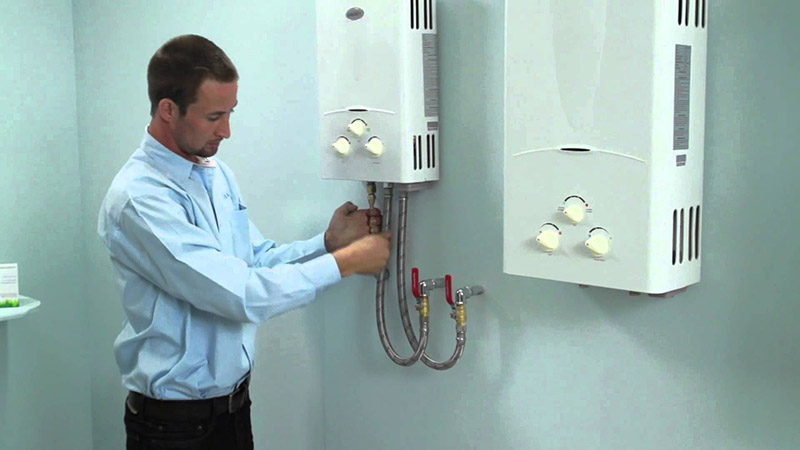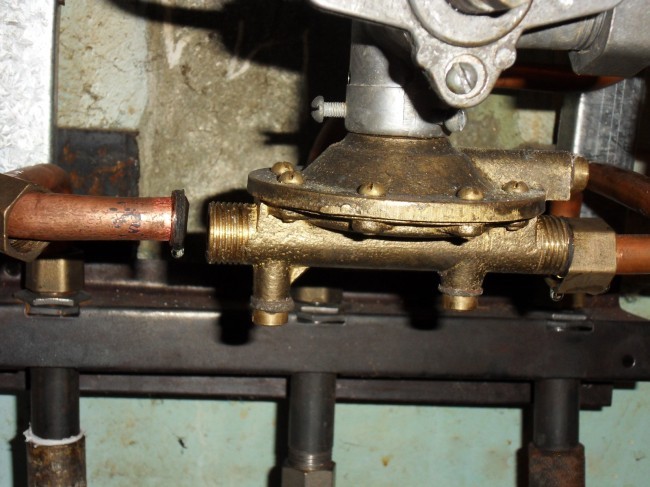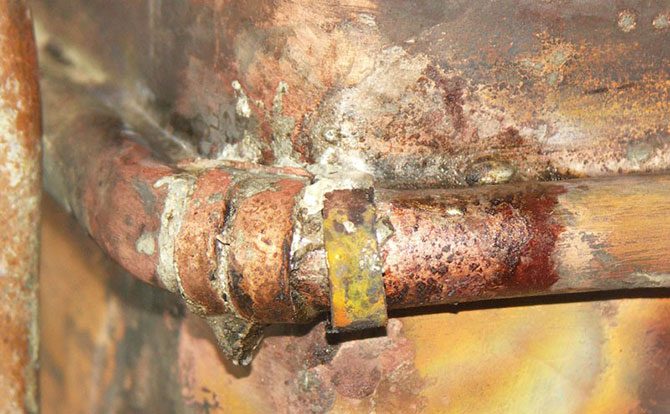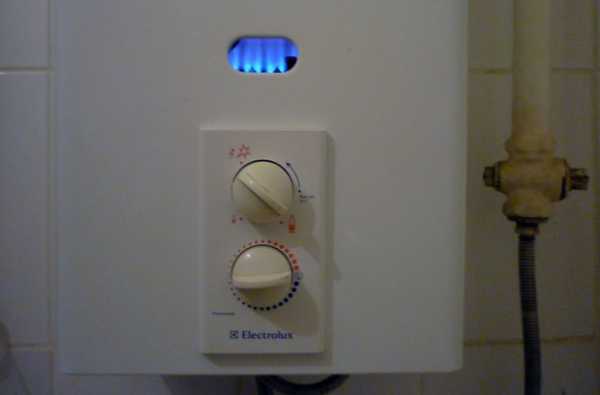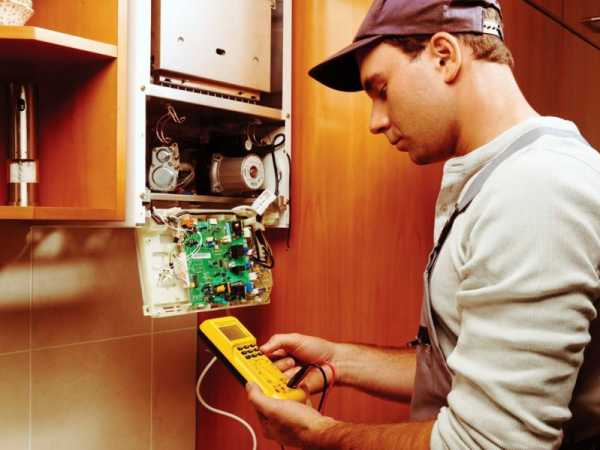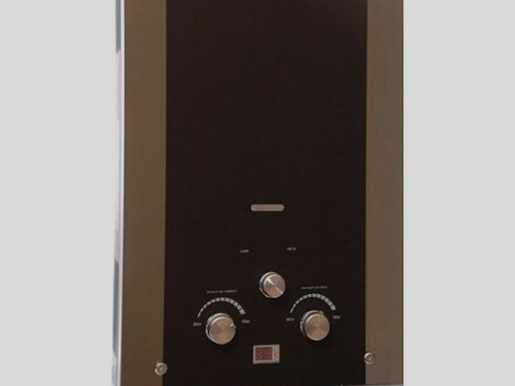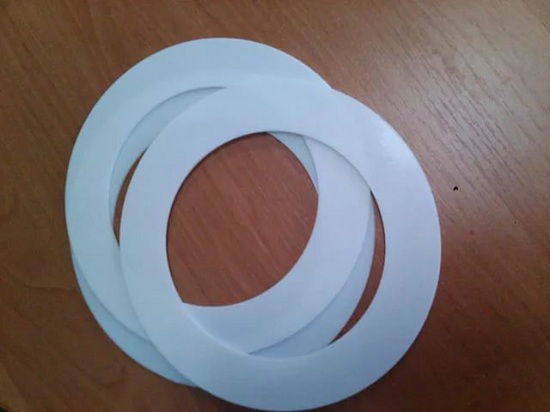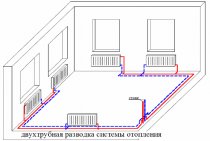How to fix a leak
Having found the cause of the leak, you can begin to eliminate it. Our further actions will depend on which part of the gas column is the source of the leak.
Radiator leak
The fact that there is a crack or hole in the radiator is indicated by the presence of green spots on this part. The procedure for fixing a leak in the radiator will be as follows:
- We block the water pipes so that water does not enter the column. Disconnect the water supply hoses from the column. Drain the remaining water from the radiator. To remove liquid from the coil, use a vacuum cleaner or pump.
- Armed with sandpaper, we clean the damaged areas. Then we treat these places with a degreasing solution and wipe dry.
- We take a soldering iron with solder, which can be used at temperatures above 180 degrees (the power of the soldering iron must be at least 100 W). Grind a piece of rosin or grind an aspirin pill into powder. Sprinkle this composition on the work surface.
- Heating the soldering iron to the desired temperature, we increase the solder to a height of about 0.2 cm.
- We repeat this procedure for each through damage.
Alexander Gerasimov in his video will show and tell you how to properly solder the gas column radiator yourself.
Leakage in threaded connections
Quite often, you can find a leak in the threaded connections between parts of the geyser
Pay attention to which pipe a leak has formed: water is usually supplied through the left pipe for heating, and gas is usually supplied through the right pipe. As a rule, water begins to leak from the pipe if the sealing gasket is worn out.
It is very easy to change this part.
- The first thing to do is to block the water supply.
- Then we disassemble the connection in which the problem is detected (we use a regular wrench for this purpose). Remove the worn gasket.
- The connecting elements are cleaned of dirt and degreased.
- If the thread on the American nut is damaged, it should be replaced.
- Then we install a new rubber gasket and assemble the connection.
Leakage in pipes
Sometimes a leak is found not in the connection of the tubes, but directly in them. Experts advise, when cracks and small holes are found in the tubes, to use the same method as for fixing leaks in the radiator, that is, soldering. However, in the absence of proper care, it is not always possible to detect damage in time. If you realize it too late, and the tube has rotted beyond repair, you will have to replace it.
Those who have encountered a similar problem say that it is very difficult to find a suitable tube, even in stores specializing in the sale of gas equipment. As a replacement for the tube, you can use a corrugated stainless steel hose or a flexible water supply.
How to properly solder the tube without damaging it and extending the life of the gas column can be seen in the video by Vladimir Pekar, which is presented below.
Scale on the heat exchanger pipes
The heat exchanger consists of a casing and pipes into which cold water enters and is heated there. In any case, over time, a small layer of scale appears inside. The main reasons for its occurrence are the high hardness of the water and the operation of the water heater at temperatures above 80 degrees.
You can repair the column without removing the heat exchanger. Turn off the gas and close the water valve. It is necessary to remove the casing from the device and drain the water. To do this, unscrew the union nut from the water inlet to the water heater and turn on the faucet that is the lowest in the system, usually the faucet in the bathroom. Geysers Termaxi have a special valve for draining water from the system.In this case, it is easier to drain the water into a substituted container.
After that, the nuts at the inlet and outlet of the heat exchanger are unscrewed and a special antiscale liquid is poured into it through a hose, which can be bought at hardware stores. You can also use a solution with vinegar or citric acid.
In this form, the column is left for several hours. Then everything is connected back and the water valve is turned on. Turn on the hot water faucet slowly. Dirty liquid should pour out. If after that the pressure has increased, then the heat exchanger pipes are cleaned. If necessary, you can repeat the entire cleaning procedure several times.
In order to avoid this breakdown, you need to use the water heater at temperatures of the order of 40-50 degrees. You can also install a filter at the inlet, which will purify the water from salts, which form scale.
Causes of problems
To troubleshoot in which the geyser clicks but does not ignite, you need to pay attention to the following:
- there is no spark from the piezoelectric element or the igniter does not work;
- the burner is hard to ignite not the first time, and then goes out;
- the water regulator is leaking;
- when you turn on the device, there is a pop.
In good condition, the device operates silently and works with a slight delay - no more than 1-2 seconds. Consider the main reasons for the clicking of the gas column igniter.
Piezo element does not spark
If the gas water heater is equipped with piezo ignition, then the following problems may occur with it:
- Errors during operation. The fact is that the water heaters have a security system that controls that the igniter first warms up and only after that it will be possible to light the wick. It is necessary to carefully study the instructions and learn how to properly ignite the device.
- There is no spark in the water heater. This is usually caused by a broken piezoelectric element or electrode. In this case, the column cannot be ignited, and then there is only one way to solve it - to replace the piezoelectric element.
- The wick does not ignite. The breakdown is associated with the failure of automation or lack of traction. The cause of the problem is also a dirty igniter that needs to be cleaned. The symptom is that the wick burns only when the gas is forced. After its termination, the wick immediately goes out. Cleaning the igniter will help solve the problem.
Replacement of elements should be entrusted only to specialists of the service center.
…

Lack of power to the igniter
The lack of power supply to the igniter of a gas column powered by a battery or a hydro generator is determined by the fact that the device does not start working when a hot water tap is opened. It is necessary to check for the following causes of water heater malfunctions:
- Dead batteries. A sign of this is that a spark appears, but it cannot ignite the burner. The column does not turn on immediately, but the electric ignition constantly clicks.
- The hydro generator does not work - a turbine that generates electricity. The element is affected by pressure and water. If the hydro generator refuses to work, then you need to clean the interior of sediment and debris. A specialist will help stabilize the pressure in the turbine with the help of pumps.
- Problems in the power supply. Often the reason for the lack of power to an electric water heater is a breakdown of the power supply unit. It can fail due to disconnection or oxidation of contacts, damage to resistors, etc. If you know how to solder, then you can fix certain problems yourself.
Note! Even powerful batteries with frequent use of the water heater last for 6-7 months. Then crashes start to occur.
Lack of ventilation or draft in the chimney
If the geyser clicks, lights up and goes out, then most likely the problem is the lack of normal traction.Over time, the chimney becomes clogged with soot, leaves, or other debris, which should be cleaned out periodically. Also, the quality of ventilation and draft may deteriorate after replacing windows, doors or changing the design of ventilation ducts. It is very simple to check their influence on the operation of the geyser - if it works well with the window open, then the matter is ventilation. To remedy the situation, an additional ventilation system will have to be arranged in the room. For example, there are special valves that are installed on plastic windows.
Leaks in the water unit
The geyser clicks and lights up late and if there are leaks in the water unit. The following signs will indicate this:
- after turning on the water, the device does not light up immediately;
- the water unit may be leaking.
The cause of leaks is a torn or deformed diaphragm assembly. It is subjected to considerable pressure during the activation process. As a result, the diaphragm can:
- stretched - then the column is turned on only with a strong pressure of water, but there will be no leakage;
- break - as a result, the water heater does not turn on the first time, there is also a leak;
- coarsen - with very hard water, various deposits accumulate on the diaphragm; as a result, it becomes coarse and does not work clearly.
Lack of optimal water pressure
The instructions for any geyser indicate the minimum water pressure at which it should work. If the burner clicks and does not ignite, the cause may be insufficient water pressure. You can solve the problem by installing a storage tank and a pump that will increase the pressure in the pipeline.
Pipe leak
You can find out the whole truth about the conspiracy related to the selection, operation and maintenance of gas water heaters (instantaneous water heaters) of all manufacturers and models.
If water began to drip from the column, the reason may be that fistulas have formed on the copper pipes. In order to find a leak, you need to carefully inspect the heat exchanger with the water turned off. Some fistulas are easy to find, you will see how water comes out of these places. Small holes can be seen from the green spots and rust around.
There are three ways to fix a leak:
Install the clamp with rubber gasket. If space permits, and the pipe does not fit snugly against the casing, the easiest, fastest and most effective way is to install a metal clamp with a rubber gasket. Despite its simplicity, this method allows you to eliminate the leak without damaging the structure.
Solder the fistula. Having previously cleaned and degreased, the place of leakage is covered with flux. After that, using a powerful soldering iron or a burner with a gas cylinder, the fistula is soldered. In this case, it is necessary to ensure that the solder covers the desired section of the pipe with a layer of 1-2 mm.
If several holes are nearby, it will be effective to solder a piece of copper plate. It is not recommended to solder cheap Chinese heat exchangers. Usually they are painted on top with paint to hide the uneven color of copper with impurities. In such columns, the pipes are too thin and will burn through during soldering.
Use cold welding
It is important to carefully read the instructions and make sure that it can withstand high temperatures. A piece of cold weld is pulled out of the package and kneaded with gloved hands until solidification begins.
After that, it is applied to the pipe and smoothed until completely hardened.
Also, a leak can form due to the fact that the gaskets are worn out. If water leaks from the pipe connections, simply replace the gaskets there with new ones.
What to do if the geyser makes noise, whistles, crackles or clicks in the photo
What to do if the geyser makes noise, whistles, crackles or clicks? in photographs.
Usually, the operation of the gas column is accompanied by sounds associated with the burning of the flame and the flow of water inside the apparatus.However, sometimes the user may hear whistling, pops and other extraneous noise from the equipment. To figure out why the column can whistle and make noise, you must first learn about the device of this type of water heater, as well as the features of the operation of gas water heaters.
Cotton when turned on
Each apparatus has a working area in which the accumulation of gas occurs during the activation of the equipment, as well as its gradual connection with air. In the case when the volume of accumulated gas and air meets the manufacturer's calculations, there will be no pops. If gas and air accumulate in excess, this causes a small volumetric explosion.
The author of the following video offers his solution to this problem. After watching his video, you can independently get rid of cotton when you turn on the geyser.
The column buzzes and makes noise during operation
Therefore, in noisy equipment, it is first of all checked for it. A lit match or a lighter is brought to the control holes or a special hatch in the upper part of the column. If the flame is deflected towards the device, the thrust is sufficient. Otherwise, you should take care of cleaning the chimney channel.
Seals in such windows interfere with the natural ventilation of the room. In this case, to eliminate noise, you just need to control the air flow.
And then to eliminate the noise, it is enough to clean the jets. A similar situation is also possible when the jets in the main burner are clogged, then after cleaning it, the hum disappears during the operation of the column.
Speaker whistles
If a monotonous loud whistle comes from the equipment, first of all, you should determine where it comes from. To do this, close the gas valve, and then open the hot water valve.
After watching the following video, it will be possible to independently clean the heat exchanger from scale without contacting the masters.
Overview What to do if the geyser makes noise, whistles, crackles or clicks? .
Weak traction
If you want to know about which gas water heaters (instantaneous water heaters) you should not choose, about the subtleties and nuances of their installation and connection, as well as hidden information on their proper maintenance of all manufacturers and models, then go here -.
Also, turbocharged columns (for example, Termaxi JSG 20R) and columns with a hydroturbine are distinguished by a complicated device. For their repair, it is also advisable to call specialists.
Below, watch 3 videos on repairing a Bosch gas column.
And now EVERY user's question and answer to it, in order to avoid financial costs as a result of improper operation or repair of the flow heater
And here it doesn’t matter which manufacturer’s device is involved in the issue. What matters is the unique situation that gave rise to this question, because as one good saying goes: “forewarned is forearmed”
A geyser, or as it is also called, a flowing water heater, has become a fairly popular household appliance among owners of private houses. A relatively small unit is able to provide several rooms with hot water. The advantage of the device is also the absence of the need for a storage tank, since the system is designed to heat water directly during use. But, like many household appliances, the water heater is prone to breakdowns and malfunctions. What to do if, for example, a geyser is leaking, and why is this happening?
If even slight deviations occur in the operation of the instantaneous water heater, it is necessary to diagnose the performance of its systems. The cause of the problem may lie in the following.
